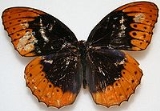
Diana Fritillary
Encyclopedia
The Diana Fritillary is a dimorphic
butterfly found in several wooded areas in southern and eastern North America (primarily in the Arkansas River
valley, several counties in South Carolina
, and spots along the Appalachian mountain range). The butterfly is the official insect of the state of Arkansas
. Males of the species exhibit an orange color on the edges of their wings, with a burnt orange underwing which does not have the typical silver scales found in most fritillary species. The female is dark blue, with dark, almost dusty underwings and is much larger than the male.
The larvae feed on violet
leaves. Dianas are unusual in that they do not lay eggs directly on the host plant, instead scattering the eggs around the plant. Upon hatching larva burrow into the ground over winter to emerge in spring. Adults feed on flower nectar and dung.
Sexual dimorphism
Sexual dimorphism is a phenotypic difference between males and females of the same species. Examples of such differences include differences in morphology, ornamentation, and behavior.-Examples:-Ornamentation / coloration:...
butterfly found in several wooded areas in southern and eastern North America (primarily in the Arkansas River
Arkansas River
The Arkansas River is a major tributary of the Mississippi River. The Arkansas generally flows to the east and southeast as it traverses the U.S. states of Colorado, Kansas, Oklahoma, and Arkansas. The river's initial basin starts in the Western United States in Colorado, specifically the Arkansas...
valley, several counties in South Carolina
South Carolina
South Carolina is a state in the Deep South of the United States that borders Georgia to the south, North Carolina to the north, and the Atlantic Ocean to the east. Originally part of the Province of Carolina, the Province of South Carolina was one of the 13 colonies that declared independence...
, and spots along the Appalachian mountain range). The butterfly is the official insect of the state of Arkansas
Arkansas
Arkansas is a state located in the southern region of the United States. Its name is an Algonquian name of the Quapaw Indians. Arkansas shares borders with six states , and its eastern border is largely defined by the Mississippi River...
. Males of the species exhibit an orange color on the edges of their wings, with a burnt orange underwing which does not have the typical silver scales found in most fritillary species. The female is dark blue, with dark, almost dusty underwings and is much larger than the male.
The larvae feed on violet
Violet (plant)
Viola is a genus of flowering plants in the violet family Violaceae, with around 400–500 species distributed around the world. Most species are found in the temperate Northern Hemisphere; however, viola species are also found in widely divergent areas such as Hawaii, Australasia, and the Andes in...
leaves. Dianas are unusual in that they do not lay eggs directly on the host plant, instead scattering the eggs around the plant. Upon hatching larva burrow into the ground over winter to emerge in spring. Adults feed on flower nectar and dung.

